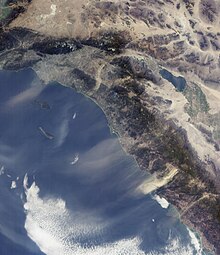Our website is made possible by displaying online advertisements to our visitors.
Please consider supporting us by disabling your ad blocker.
Santa Ana winds

The Santa Ana winds, also sometimes called the devil winds,[1][2] are strong, extremely dry downslope winds that originate inland and affect coastal Southern California and northern Baja California. They originate from cool, dry high-pressure air masses in the Great Basin.
Santa Ana winds are known for the hot, dry weather that they bring in autumn (often the hottest of the year), but they can also arise at other times of the year.[3] They often bring the lowest relative humidities of the year to coastal Southern California, and "beautifully clear skies".[4] These low humidities, combined with the warm, compressionally-heated air mass, plus high wind speeds, create critical fire weather conditions and fan destructive wildfires.[4]
Typically, about 10 to 25 Santa Ana wind events occur annually.[5] A Santa Ana can blow from one to seven days, with an average wind event lasting three days.[6] The longest recorded Santa Ana event was a 14-day wind in November 1957.[5] Damage from high winds is most common along the Santa Ana River basin in Orange County, the Santa Clara River basin in Ventura and Los Angeles County, through Newhall Pass into the San Fernando Valley of Los Angeles County, and through the Cajon Pass into San Bernardino County near San Bernardino, Fontana, and Chino.[6]
- ^ Masters, Nathan (October 25, 2012). "SoCal's Devil Winds: The Santa Anas in Historical Photos and Literature". KCET. Archived from the original on October 29, 2012. Retrieved May 3, 2012.
Scholars who have looked into the name's origins generally agree that it derives from Santa Ana Canyon, the portal where the Santa Ana River -- as well as a congested Riverside (CA-91) Freeway -- leaves Riverside County and enters Orange County. When the Santa Anas blow, winds can reach exceptional speeds in this narrow gap between the Puente Hills and Santa Ana Mountains.
- ^ Needham, John (March 12, 1988). "The Devil Winds Made Me Do It : Santa Anas Are Enough to Make Anyone's Hair Stand on End". Los Angeles Times. Archived from the original on April 29, 2014. Retrieved May 3, 2013.
- ^ Smith, Joshua Emerson (January 31, 2019). "Climate change should tamp down California's wildfire-fanning Santa Ana winds, study finds". Los Angeles Times. Retrieved February 3, 2019.
- ^ a b Pitt, Leonard (1997). Los Angeles A to Z: an encyclopedia of the city and county. Dale Pitt. Berkeley: University of California Press. p. 452. ISBN 0-520-20274-0. OCLC 35955263.
- ^ a b Cite error: The named reference
:3was invoked but never defined (see the help page). - ^ a b Cite error: The named reference
:4was invoked but never defined (see the help page).
Previous Page Next Page


